prescriptive residential wood deck construction guide
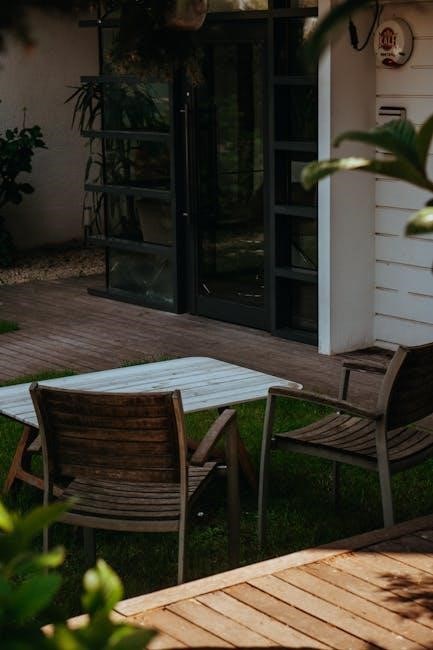
This guide provides essential information for constructing safe and durable residential wood decks‚ referencing the International Residential Code (IRC). It covers design‚ materials‚ and construction methods to ensure compliance with local building codes‚ focusing on safety‚ structural integrity‚ and proper installation techniques. The document serves as a practical resource for homeowners and contractors‚ outlining prescriptive requirements for building code-compliant decks that meet or exceed minimum standards for performance and safety.
Overview of the Guide
This guide aligns with the International Residential Code (IRC)‚ providing detailed requirements for designing and constructing safe‚ durable wood decks. It covers material selection‚ structural components‚ and safety measures‚ ensuring compliance with local building codes. The guide serves as a comprehensive resource for homeowners‚ contractors‚ and builders‚ offering prescriptive methods that meet or exceed IRC standards. It emphasizes proper construction techniques‚ load calculations‚ and maintenance tips to ensure long-lasting‚ secure outdoor structures that enhance residential properties while adhering to safety regulations.
Importance of Code-Compliant Construction
Code-compliant construction ensures safety‚ durability‚ and structural integrity for residential wood decks. Adhering to the International Residential Code (IRC) minimizes risks of collapses and ensures decks can withstand various loads and environmental conditions. Compliance also protects homeowners from legal liabilities and potential costly repairs. By following IRC guidelines‚ builders ensure decks are constructed with approved materials and methods‚ guaranteeing long-term performance and reliability while meeting local building standards and enhancing property value through safe and well-engineered outdoor spaces.

Material Selection for Wood Decks
Choosing the right materials is critical for a durable and safe wood deck. Code-approved lumber‚ preservative-treated wood‚ and corrosion-resistant fasteners are essential for withstanding outdoor conditions and ensuring longevity.
Code-Approved Lumber Requirements
Code-approved lumber ensures safety and durability in deck construction. Pressure-treated wood is required for structural components in contact with the ground to resist rot and insect damage. Lumber must meet ASTM standards and bear grading stamps from approved agencies. Joists‚ beams‚ and ledger boards must be rated for outdoor use. Fasteners and connectors must be corrosion-resistant and compatible with treated wood. Always verify local building codes for specific material requirements‚ as they may vary based on regional conditions and regulations.
Preservative-Treated Wood for Durability
Preservative-treated wood is essential for deck components exposed to moisture or soil contact. Pressure-treated lumber resists rot‚ decay‚ and insect damage‚ ensuring long-term structural integrity. Look for wood treated with approved preservatives like alkaline copper quaternary (ACQ) or borates. Always follow manufacturer guidelines for treatment levels based on exposure conditions. Properly treated wood extends deck lifespan and enhances safety. Ensure all structural elements in contact with the ground are treated to meet code requirements and prevent premature deterioration.
Fasteners and Hardware for Deck Construction
Proper fasteners and hardware are critical for deck safety and durability; Use galvanized or stainless steel nails‚ screws‚ or bolts to resist corrosion. Structural connectors‚ such as joist hangers and post anchors‚ ensure secure joints and distribute loads evenly. Always follow manufacturer recommendations for sizing and spacing. Coated or hot-dipped fasteners are ideal for outdoor conditions. Ensure all hardware meets code standards to prevent failure and maintain structural integrity. Proper installation of fasteners is vital for a safe and long-lasting deck.
Deck Finishes and Protective Coatings
Deck finishes and protective coatings enhance durability and aesthetics while protecting against moisture and UV damage. Use water-repellent preservatives or waterproof sealants to maintain wood integrity. Stains and paints offer color options but must be compatible with the wood type. Always follow manufacturer instructions for application and drying times. Properly prepared surfaces ensure better adhesion and longevity. Regular reapplication is essential to maintain protection and appearance‚ especially in harsh weather conditions. Choose finishes that complement the deck design while providing lasting defense against environmental factors.

Deck Foundation and Footing Requirements
A sturdy foundation ensures structural stability‚ with footings and piers providing support. Proper depth and anchoring are critical‚ while drainage and frost depth must be considered.
Footings and Piers for Deck Support
Footings transfer deck loads to the ground‚ preventing settling or shifting. Typically‚ concrete footings are required‚ with depths varying based on frost lines and soil conditions. Piers extend from footings to support posts‚ ensuring stability. Sized to carry structural loads‚ footings must meet local code requirements. Properly constructed footings and piers are essential for safety and durability. They prevent uneven settling and protect against soil movement. Always consult local building codes for specific sizing and material guidelines to ensure compliance and structural integrity.
Foundation Depth and Soil Conditions
Foundation depth varies based on local frost lines and soil types. In frost-prone areas‚ footings must extend below the frost line to prevent heaving. Soil conditions‚ such as stability and bearing capacity‚ influence footing design. Sandy soils typically require deeper footings than clay soils. A geotechnical report may be needed for unstable soil. Local building codes provide specific requirements for foundation depth and soil preparation. Proper foundation depth ensures structural stability and prevents settling issues over time. Always consult local regulations for precise guidelines.
Anchoring the Deck to the House
Proper anchoring ensures the deck remains secure and stable. Ledger boards are typically attached to the house framing using through-bolts or lag screws. The connection must resist uplift and lateral loads. Flashing should be installed between the ledger and the house to prevent water infiltration. Hold-downs or tie-downs may be required‚ especially in high-wind or seismic areas. The number and type of fasteners depend on the deck’s size and local building codes. Always ensure the ledger is attached to the house’s structural framing‚ not just siding or trim‚ for maximum stability and safety.
Framing and Structural Connections
Framing and structural connections are critical for deck stability. Beams‚ joists‚ and ledgers must be properly sized and spaced to distribute loads evenly and ensure safety.
Ledger Board Attachment
Ledger Board Attachment
Proper ledger board attachment is critical for deck safety. The ledger board must be securely fastened to the house framing using approved fasteners like lag screws or through-bolts. Ensure the board is level and aligned with the house’s framing. Use pressure-treated lumber for durability. Fasteners should be spaced 16 to 24 inches on center‚ depending on local codes. Flashing must be installed over the ledger to prevent water intrusion. A continuous connection to the house framing ensures structural integrity and prevents deck collapse. Always follow local building codes for secure attachment methods.
Joist Spans andSpacing
Joist Spans and Spacing
Joist spans and spacing are critical for deck structural integrity. Joists must be spaced 16 or 24 inches on center‚ depending on decking material and local codes. Maximum joist span is determined by lumber size and species‚ typically ranging from 6 to 12 feet. Ensure joists are level and securely attached to beams or ledger boards. Proper spacing prevents sagging and ensures even weight distribution. Always consult local building codes for specific requirements and use approved lumber for durability and safety. Correct installation enhances deck stability and longevity.
Beams and Header Requirements
Beams and headers are essential for supporting deck loads and ensuring structural stability. Beams are typically larger dimensional lumber or engineered wood products‚ sized based on the deck’s design load‚ usually 40 psf for residential decks. Headers span openings between supporting posts and must be properly sized to carry joist loads. Both beams and headers should be constructed from pressure-treated lumber for durability. Proper installation involves securing beams to footings or posts and ensuring they are level. Always follow local building codes for specific sizing and material requirements to ensure safety and compliance.
Structural Connectors and Fasteners
Structural connectors and fasteners are critical for ensuring the integrity and safety of a wood deck. Joist hangers‚ post anchors‚ and beam brackets are essential for securing connections between deck components. These connectors must be made of corrosion-resistant materials‚ such as galvanized or stainless steel‚ to withstand outdoor conditions. Deck screws and bolts should be rated for structural use and spaced according to manufacturer guidelines. Proper tightening is crucial to prevent looseness over time. Always follow the manufacturer’s instructions for installation to ensure a secure and durable structure.

Deck Railings and Guards
Deck railings and guards are essential for safety‚ preventing falls‚ and meeting code requirements. They must be sturdy‚ well-designed‚ and constructed from durable materials to ensure stability and compliance.
Minimum Height and Design Requirements
Deck railings must meet specific height and design standards for safety. The minimum railing height is typically 36 inches‚ measured from the deck surface to the top rail. Designs must ensure structural integrity‚ with railings capable of withstanding a 50-pound load per square foot. Materials like wood‚ metal‚ or composite must be durable and code-compliant. The top rail should be continuous and graspable‚ while balusters or intermediate guards must be spaced no more than 4 inches apart to prevent accidents‚ especially in homes with children or pets.
Balusters and Spacing
Balusters and Spacing
Balusters‚ the vertical posts between deck railings‚ must be spaced to ensure safety and meet code requirements. The maximum allowable spacing between balusters is 4 inches‚ measured center-to-center‚ to prevent small children from slipping through. This spacing ensures compliance with the International Residential Code (IRC) and enhances safety. Balusters should be securely fastened to the top and bottom rails‚ providing stability and meeting structural load requirements. Proper spacing and attachment are critical to prevent accidents and ensure the railing system functions as intended.
Post-to-Deck and Post-to-House Connections
Secure post-to-deck and post-to-house connections are critical for deck stability and safety. Deck posts must be anchored to the deck frame using approved hardware like post anchors or brackets‚ ensuring they can resist vertical and horizontal loads. When attaching posts to the house‚ they should be connected to the ledger board with lag screws or bolts‚ spaced no more than 24 inches apart. Proper flashing should be installed where posts meet the house to prevent water intrusion. Always follow local building codes for specific requirements.
Cable Railings and Alternative Systems
Cable railings offer a modern‚ sleek appearance with horizontal or vertical cables‚ providing unobstructed views. Alternative systems include glass panels and metal rods‚ which are durable and contemporary. Proper installation is crucial‚ ensuring cables are tightly secured with tensioners to meet safety codes. These systems must withstand specific loads and adhere to local building codes. Maintenance involves periodic tightening and replacement of worn cables. Aesthetically‚ they enhance deck appeal but may not suit all styles. Cost varies‚ with potential long-term benefits in durability. Ensure secure attachment to deck posts for stability.
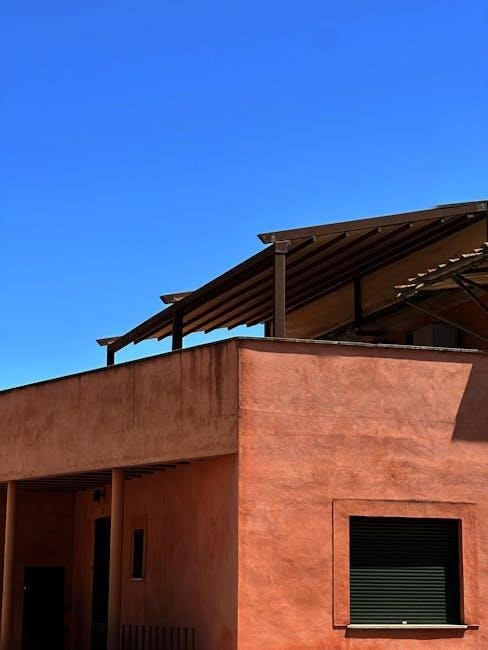
Decking Boards and Installation
Decking boards are installed horizontally‚ spaced 1/4″ for drainage and expansion. Secure with screws or nails for stability and safety‚ ensuring proper alignment and spacing.
Decking Material Options
Decking materials vary in durability‚ cost‚ and maintenance. Pressure-treated lumber is a cost-effective choice for its resistance to rot and insects. Naturally durable woods‚ like redwood and cedar‚ offer aesthetic appeal and natural resistance to decay without chemical treatment. Composite decking combines wood fibers and plastic for low-maintenance‚ weather-resistant surfaces. Exotic hardwoods‚ such as Ipe‚ provide exceptional strength and longevity‚ though at a higher cost. Each material must meet local building codes and climate considerations for optimal performance and safety.
- Pressure-treated lumber for affordability and durability.
- Naturally durable woods for rot resistance and beauty.
- Composite decking for minimal upkeep and versatility.
- Exotic hardwoods for premium strength and appearance.
Installation Patterns and Spacing
Decking boards can be installed in various patterns to enhance aesthetics and structural integrity. Common layouts include simple linear‚ diagonal‚ or herringbone designs. Proper spacing between boards is crucial for drainage and thermal expansion. A 1/8 to 1/4 inch gap is typically recommended‚ depending on the material. Hidden fasteners can be used for a sleek appearance‚ while face-nailing provides added security. Ensure spacing consistency by using a spacer tool or template. Always verify local building codes for specific requirements to guarantee safety and durability.
- Use consistent spacing for a professional finish.
- Consider hidden fasteners for a clean look.
- Verify local codes for specific spacing requirements.
Fastening Decking Boards Securely
Securing decking boards properly ensures safety and longevity. Use screws or nails designed for outdoor use‚ avoiding staples for better durability. Hidden fasteners provide a clean finish‚ while face-nailing or screwing offers added security. Pre-drill holes for screws to prevent splitting‚ especially with pressure-treated wood. Space fasteners 12-16 inches apart for joists and 8-12 inches for beams. Use a spacer tool to maintain consistent spacing and alignment. Always follow manufacturer guidelines and local building codes for fastening requirements to ensure a sturdy and safe deck structure.
- Pre-drill holes to avoid splitting wood.
- Space fasteners evenly for optimal support.
- Follow manufacturer and local code specifications.
Ventilation and Moisture Protection
Proper ventilation prevents moisture buildup‚ reducing rot and decay. Use pressure-treated wood‚ ensure adequate spacing‚ and install flashing to shield decking from water damage and prolong durability.
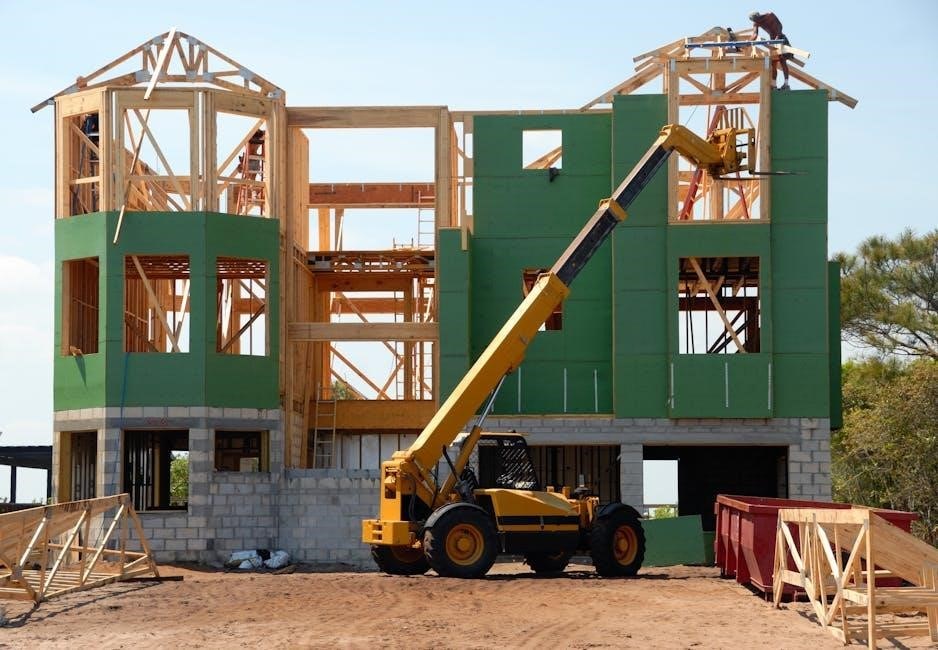
Importance of Proper Ventilation
Proper ventilation is essential to prevent moisture accumulation‚ which can lead to rot‚ decay‚ and structural damage. Adequate airflow beneath the deck reduces humidity‚ minimizing mold and mildew growth. It also helps prevent warping and premature deterioration of decking materials. Ensuring sufficient ventilation enhances the deck’s longevity by maintaining a dry environment‚ even in wet or humid climates. Poor ventilation can lead to costly repairs‚ making it a critical factor in deck durability and safety. Always follow local building codes for ventilation requirements.
Flashings and Waterproofing
Flashings and waterproofing are critical to protect decks from water damage. Flashings are installed at vulnerable areas‚ such as the ledger board and around posts‚ to prevent water infiltration. Waterproofing membranes or coatings are applied to horizontal surfaces like deck boards and joists to shield them from moisture. Proper flashing and waterproofing prevent rot‚ decay‚ and structural issues. They also safeguard the ledger board connection to the house‚ ensuring long-term stability and safety. Always follow manufacturer guidelines for installation to maximize effectiveness and durability.
Fire Safety and Ignition-Resistant Materials
Fire safety is crucial in deck construction to prevent ignition and spread of flames. Use ignition-resistant materials‚ such as treated wood or fire-rated products‚ especially in wildfire-prone areas. Proper assembly methods and spacing can reduce fire risks‚ while maintaining a safe distance from heat sources like grills or fire pits is essential. Regular inspections ensure compliance with fire codes and standards‚ promoting a safer outdoor living space for homeowners.
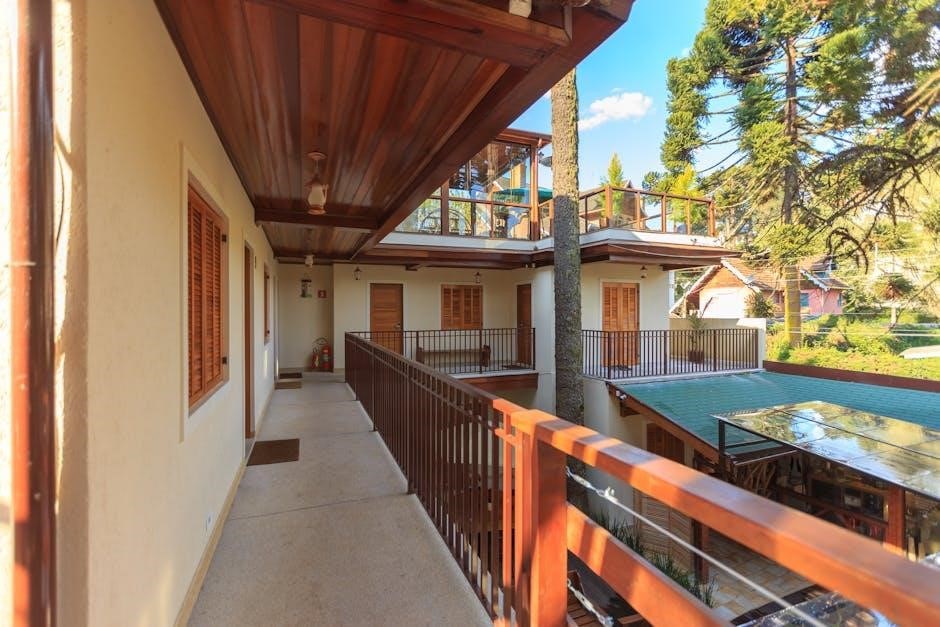
Fire-Resistant Materials for Decks
Fire-resistant materials are essential for decks to minimize ignition risks. Pressure-treated wood with fire-retardant chemicals is a common choice. Composite decking‚ made from wood-plastic blends‚ often includes fire-resistant additives. Natural woods like redwood and cedar can be treated for enhanced fire resistance. Fire-resistant materials are particularly important in wildfire-prone areas. Always check local building codes for specific requirements. Proper installation and maintenance of these materials ensure safety and compliance with fire safety standards‚ protecting both the deck and surrounding structures from potential hazards.

Firestopping and Clearances
Firestopping involves sealing gaps and joints to prevent fire spread. For decks‚ this includes sealing around structural elements and openings. Clearances are critical to minimize fire hazards‚ requiring decks to be a safe distance from combustible materials. Local codes specify minimum clearances‚ often based on deck height and location. Proper firestopping materials‚ like fire-rated sealants‚ must be used to maintain fire resistance. Ensuring adequate clearances and effective firestopping helps protect the deck and surrounding structures from fire risks‚ aligning with safety standards and building regulations.

Inspection and Maintenance
Regular inspections ensure deck safety and longevity. Check for damage‚ rot‚ or loose connections. Address issues promptly to prevent structural compromise and maintain the deck’s integrity effectively.
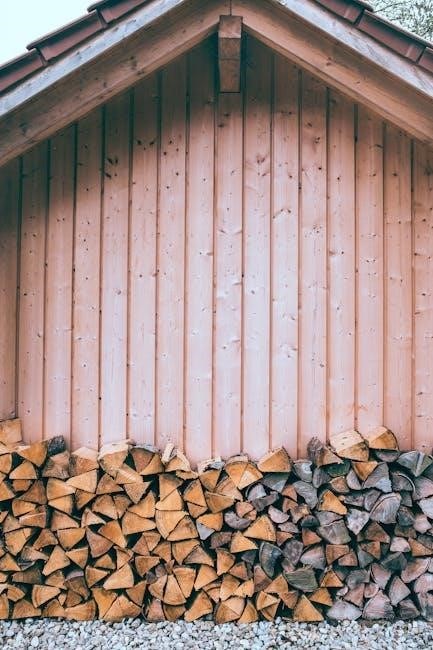
Regular Inspection Requirements
Regular inspections are crucial for ensuring deck safety and identifying potential issues early. Inspect the ledger board‚ joists‚ beams‚ and hardware for signs of rot‚ damage‚ or wear. Check all fasteners and connections to ensure they are secure and tightened properly. Examine decking boards for splinters‚ cracks‚ or excessive gaps. Assess railings‚ balusters‚ and guards for stability and proper spacing. Inspect flashings and waterproofing systems to prevent moisture damage. Regular inspections help maintain structural integrity and prevent costly repairs over time.
Maintenance Tips for Longevity
Regular maintenance is essential to extend the life of a wood deck. Clean the deck annually with a mild detergent and water to remove dirt and mildew. Apply protective coatings like sealers or stains to shield the wood from weathering. Inspect and replace damaged or rotting boards promptly. Tighten loose fasteners and hardware to ensure structural stability. Trim vegetation near the deck to reduce moisture retention. Avoid using harsh chemicals or excessive water pressure‚ which can damage finishes. Seasonal inspections and proactive care prevent deterioration and ensure safety.
Local Codes and Permits
Ensure compliance with local building codes and regulations for deck construction. Secure necessary permits to guarantee safety and legal compliance‚ avoiding potential fines or project halts.
Obtaining Necessary Permits
Before starting construction‚ obtain all required permits from your local building department. Submit detailed plans‚ including deck design‚ materials‚ and dimensions‚ for approval. Ensure compliance with local zoning laws and regulations. Permits typically include a building permit and inspections at key stages‚ such as footing installation and final deck completion. Failure to secure permits may result in fines or project delays. Always consult with local authorities to confirm specific requirements for your area.
Adhering to Local Building Codes
Always adhere to local building codes and regulations when constructing a residential wood deck. These codes ensure safety and durability by setting standards for materials‚ design‚ and construction methods. Research and understand specific requirements for your area‚ including load-bearing capacities‚ railing heights‚ and structural details; Local codes may vary‚ so consult with building officials to confirm compliance. Regular inspections during construction ensure adherence to these standards‚ preventing potential issues and ensuring a safe‚ durable deck.